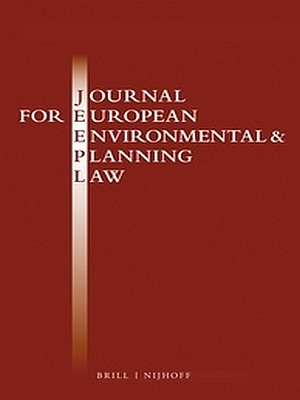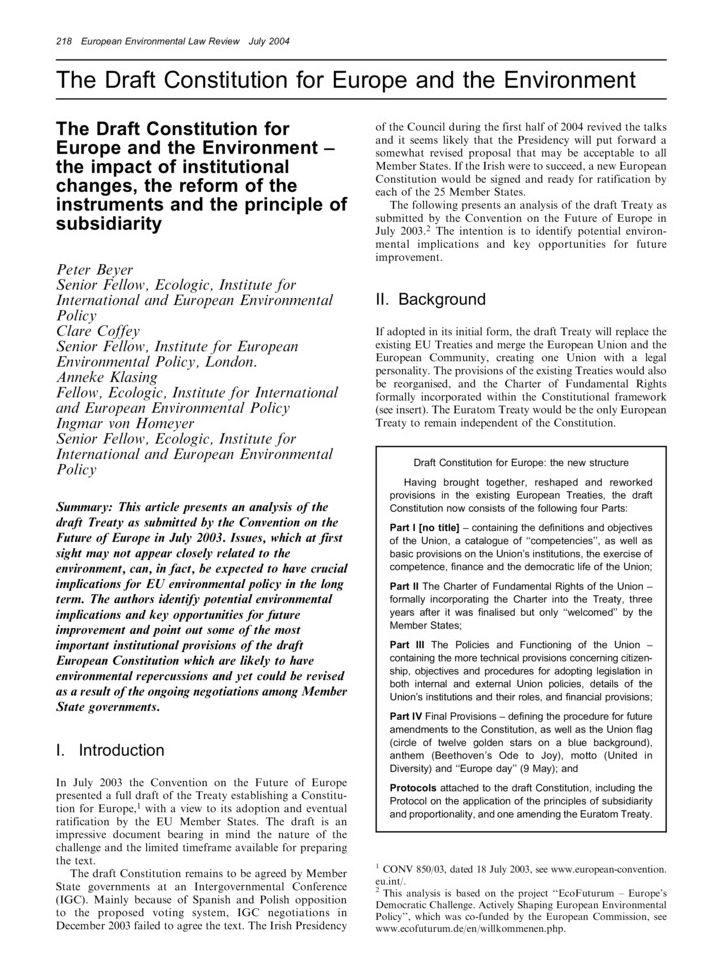
The Environment in the Future European Constitution
- Publication
- Citation
Beyer, Peter 2004: “The Environment in the Future European Constitution”. Journal for European Environmental & Planning Law (JEEPL), Vol. 1, No. 2, 143-151.
In the second issue of the new Journal for European Environmental & Planning Law (JEEPL) Peter Beyer published an article on the status of the environment in the future European Constitution.
The article is based on a brochure the author wrote for the project "EcoFuturum – A Sustainable Constitution for Europe" which was co-funded by the European Commission. In the framework of this project, Ecologic published a number of policy papers and carried out a series of workshops throughout the enlarged European Union to discuss the impact of the future Constitution on European environmental policy.
Following an introduction (I.) and some general remarks on the character and structure of the new Treaty (II.), the contribution focuses on the articles of the Treaty directly dealing with the environment (III.), although the modifications of the institutional set-up of the Union and the hierarchy of norms might have an even greater impact on the future of environmental policy.
The news that "Europe is giving itself a constitution" made a headline in June 2003 when the Convention on the Future of Europe adopted the "Draft Treaty establishing a Constitution for Europe". After 16 months of debate, Chairman of the Convention Valéry Giscard d'Estaing presented the draft Treaty to the European Council as hosted by the Greek Presidency in Thessaloniki. Reactions throughout Europe to the draft Constitution varied between confusion, hope, fear, outrage and boredom. Some considered it "a lamentable piece of work", while others welcomed it as a big step forward and an excellent draft.
But both "Federalists" and "Euroskeptics" will certainly agree on one point: the Constitution is essential to the gradual development of European primary law and will be decisive for the future of the European Union. The Thessaloniki Summit welcomed the draft as "a good basis for starting in the Inter-Governmental Conference". The Inter-Governmental Conference then debated the draft beginning in October 2003 with a meeting of the European leaders in Rome. In the following two months, the Ministers for Foreign Affairs and the Heads of State or Government met several times to hammer out a compromise on different controversial issues, in first line the question of the future arrangements for qualified majority voting in the Council and the composition of the European Commission. However, at the end of the year and the Italian Presidency, no overall agreement on the Constitution was reached. This was mainly due to the fierce opposition from Spain and Poland against the reform of qualified majority voting in the Council.
The arrangements proposed by the Convention would have meant a lost of influence for these two countries in comparison to the current situation under the Nice Treaty. Hence, the Irish Presidency had to pick up the issue and continue the consultations. On the basis of a report submitted by the Presidency in March 2004 finally Member States overcame their power struggles and passed the European Constitution at their June 2004 summit. In October this year they will gather again, this time in Rome, to sign the Treaty establishing a European Constitution in the same room where the founding Treaty of Rome was signed in 1957. The new Treaty is then due to go into effect in 2006 under the condition that all 25 Member States are going to ratify it. Whether this will be the case is difficult to say as several Member State, including the UK, France and Poland, plan to held referendums on the constitution. The outcome of these referenda is, especially in the UK, rather uncertain.



